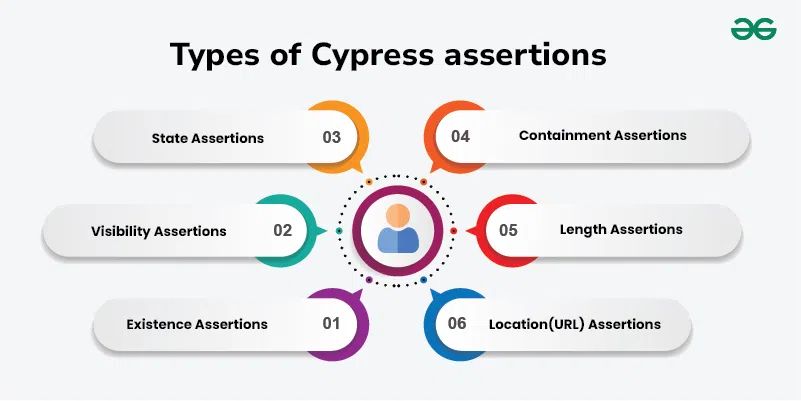|
Cypress is an open-source website testing tool that is used to automate tests for JavaScript web applications. It is designed for end-to-end testing and it can be used for unit tests and integration tests as well. It is fast, reliable, and can run in real-time directly in the browser.
It’s built to work with any front-end framework or website, including React, Angular, and Vue. In this article, we will learn about Assertions in cypress.
Assertions in CypressAssertions is used to verify if certain conditions are met during the execution of test. This is used to verify that the thing that we have written in our script should be done. Ex, Suppose there is a gender-select radio button and in our test script we have written to choose Male, so by binding assertion method we can verify that it must have selected Male radio.
 Assertions in Cypress 1. Implicit AssertionsImplicit assertions are built into the command chain and automatically assert the desired condition. You don’t need to call an assertion method. The assertion is made as part of the command. It includes commands such as cy.get(), cy.contains().
2. Explicit AssertionsExplicit assertions are made using the .should() or .and() methods. It is bind (appended) after a commands such as cy.get(), cy.contains etc.. These assertions are more flexible and allow you to specify exactly what you want to assert. You can pass the different assertions such as have.value, exist, not.exist etc.. inside .should or .and() command.
Different Types of Assertions with CommandsDifferent types of assertions included:
 Types of Cypress assertions 1. Existence Assertionsexist
cy.get(‘#element’).should(‘exist’);
not exist
cy.get(‘#element’).should(‘not.exist’);
2. Visibility Assertionsbe visible
cy.get(‘#element’).should(‘be.visible’);
not be visible
cy.get(‘#element’).should(‘not.be.visible’);
be hidden
cy.get(‘#element’).should(‘be.hidden’);
not be hidden
cy.get(‘#element’).should(‘not.be.hidden’);
3. State Assertionsbe checked
cy.get(‘#checkbox’).should(‘be.checked’);
not be checked
cy.get(‘#checkbox’).should(‘not.be.checked’);
be enabled
cy.get(‘#button’).should(‘be.enabled’);
be disabled
cy.get(‘#button’).should(‘be.disabled’);
be focused
cy.get(‘#input’).should(‘be.focused’);
4. Containment Assertionscontain
cy.get(‘#element’).should(‘contain’, ‘text’);
not contain
cy.get(‘#element’).should(‘not.contain’, ‘text’);
have text
cy.get(‘#element’).should(‘have.text’, ‘exact text’);
not have text
cy.get(‘#element’).should(‘not.have.text’, ‘exact text’);
have html
cy.get(‘#element’).should(‘have.html’, ‘<span>HTML</span>’);
not have html
cy.get(‘#element’).should(‘not.have.html’, ‘<span>HTML</span>’);
have value
cy.get(‘#input’).should(‘have.value’, ‘value’);
not have value
cy.get(‘#input’).should(‘not.have.value’, ‘value’);
have class
cy.get(‘#element’).should(‘have.class’, ‘class-name’);
not have class
cy.get(‘#element’).should(‘not.have.class’, ‘class-name’);
have attr
cy.get(‘#element’).should(‘have.attr’, ‘attribute’, ‘value’);
not have attr
cy.get(‘#element’).should(‘not.have.attr’, ‘attribute’);
5. Length Assertionshave length
cy.get(‘.items’).should(‘have.length’, 3);
not have length
cy.get(‘.items’).should(‘not.have.length’, 3);
have length greater than
cy.get(‘.items’).should(‘have.length.gt’, 3);
have length greater than or equal to
cy.get(‘.items’).should(‘have.length.gte’, 3);
have length less than
cy.get(‘.items’).should(‘have.length.lt’, 3);
have length less than or equal to
cy.get(‘.items’).should(‘have.length.lte’, 3);
6. Location(URL) Assertionshave url
cy.url().should(‘have.url’, ‘https://example.com’);
have title
cy.title().should(‘have.title’, ‘Page Title’);
have querycy.location(‘search’).should(‘have.query’, ‘?param=value’);
have hash
cy.location(‘hash’).should(‘have.hash’, ‘#section’);
Installation Steps of Cypress AssertionsBefore we begin make sure node.js in installed in your system.
Step 1: Create a Project Folder and move to it by using following command.
mkdir cypress cd cypress
Step 2: Initialize a project and Install Cypress.
npm init -y npm install cypress –save-dev
Step 3: After Creating a Project, Run this command to start cypress.
npx cypress open
Step 4: Testing type, Configuration and creating a spec.
- Choose a E2E Testing or Component Testing, then after quick configuration choose browser.
- After that create a new spec then click on your spec name to open your spec in any IDE.
Step 5: Testing HTML File.
- Create a HTML File and open it with any live server extension.
- copy that live server file serve link, for later use.
Example of Cypress AssertionsThe below example demonstrate the Assertion in Cypress.
HTML
<!-- index.html -->
<!DOCTYPE html>
<html lang="en">
<head>
<meta charset="UTF-8">
<title>Login Form</title>
</head>
<body>
<h1>Login</h1>
<form id="loginForm">
<label for="username">Username:</label>
<input type="text" id="username" name="username">
<br><br>
<label for="password">Password:</label>
<input type="password" id="password" name="password">
<br><br>
<button type="button" id="loginButton" disabled>Login</button>
</form>
<p id="errorMessage" style="display: none; color: red;">Invalid credentials</p>
<p id="welcomeMessage" style="display: none;">Welcome, <span id="user"></span>!</p>
<script>
document.getElementById('username').addEventListener('input', enableButton);
document.getElementById('password').addEventListener('input', enableButton);
function enableButton() {
const username = document.getElementById('username').value;
const password = document.getElementById('password').value;
document.getElementById('loginButton').disabled = !(username && password);
}
document.getElementById('loginButton').addEventListener('click', () => {
const username = document.getElementById('username').value;
const password = document.getElementById('password').value;
if (username === 'correctUser' && password === 'correctPass') {
document.getElementById('welcomeMessage').style.display = 'block';
document.getElementById('user').textContent = username;
document.getElementById('errorMessage').style.display = 'none';
} else {
document.getElementById('errorMessage').style.display = 'block';
document.getElementById('welcomeMessage').style.display = 'none';
}
});
</script>
</body>
</html>
// gfg.cy.js
describe('Login Form Functionality', () => {
it('should verify the login form elements and functionality', () => {
// 1. Visit the login page
cy.visit('http://127.0.0.1:5500/index.html');
// 2. Verify the presence and visibility of the login form elements
cy.get('#username').should('exist').and('be.visible');
cy.get('#password').should('exist').and('be.visible');
cy.get('#loginButton').should('exist').and('be.visible');
// 3. Verify that the login button is initially disabled
cy.get('#loginButton').should('be.disabled');
// 4. Enter an incorrect username and password
cy.get('#username').type('wrongUser');
cy.get('#password').type('wrongPass');
cy.get('#loginButton').should('be.enabled').click();
// 5. Verify error message is displayed
cy.get('#errorMessage').should('exist').and('be.visible').and('contain', 'Invalid credentials');
// 6. Enter a correct username and password
cy.get('#username').clear().type('correctUser');
cy.get('#password').clear().type('correctPass');
cy.get('#loginButton').click();
// 7. Verify the welcome message is displayed and contains the correct username
cy.get('#welcomeMessage').should('exist').and('be.visible').and('contain', 'Welcome, correctUser');
cy.get('#errorMessage').should('not.be.visible');
});
});
Output
Conclusion
In conclusion, Cypress is an end-to-end automated testing tool that enables efficient and reliable testing of web applications. You can verify the state of an element, input by using Assertions. By following this article, You can learn to Verify the state using assertion methods. Cypress commands are easy-to-write that make it an ideal choice for automating the testing of elements and other web components.
Frequently Asked Questions on Assertions in CypressWhat is Cypress?Cypress is a end-to-end testing framework that allows you to write tests script thatinteract with the application in a way that simulates user behavior.
What is Assertion in CypressAssertions are commands used to verify that certain conditions are met during the execution of a test.
How do you assert that an element is not present in the DOM?To check element is not present in DOM, you can use the following command:cy.get(‘#element’).should(‘not.exist’);
How do you assert that a checkbox is checked?To check if the checkbox is checked or not, you can use the following command:cy.get(‘#checkbox’).should(‘be.checked’);
|


